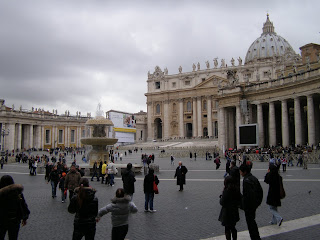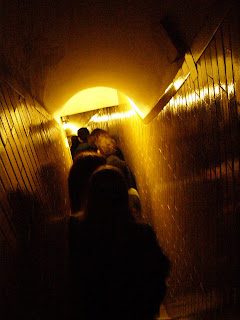Following the steady line of people, like a trail of bread crumbs leading to the altar after Sunday mass, we skirted the wall that surrounds the Vatican grounds, through some lofty arches and into Saint Peter's Square. I'm not sure why, because it happens every time, but I was surprised at how affected I felt. I'm not a particularly religious person in the sense that I don't believe in any one thing or follow any one organised religion and although I am certainly not Catholic, I am the daughter of a liberal theologian and Presbyterian minister who has been a teacher of World Religion at tertiary institutions since I was born. Religious performance, ritual and practice, in it's many forms and guises is, to me, an expression of culture, of people and of being. It's human nature, a primal instinct. People have been doing it for as long as we have existed, in fact the further back you go the more superstitious we become. Saint Peter's Square and the Basillica represent the symbolic mother lode of, at the very least, the Catholic church if not Christendom as a whole. The mighty and majestic basillica is the largest church building in the world able to hold 60 000 people within her belly. As what must surely amount to a magnanimous act of piety and devotion as great as the ancient Egyptian temples or the temples of Angkor Wat, Saint Peter's was built entirely by hand.
The square that lies before the basillica was designed, by Bernini, to give the greatest number of people a decent view of the Pope as he gives his blessing, from either the middle of the façade of the church or from a window in the Vatican Palaceby. Bernini, a deeply religious man, had to contend with an already placed obelisk, a large fountain off to one side and an irregularly shaped open area. He solved the balance problem by placing a matching fountain on the opposite side of the Egyptian obelisk and by dividing the entire area in two. The space immediately in front of the church is trapezoidal, narrowing as it moves out into the square making the facade of the church seem even bigger than it already is. The main area of the piazza is a huge ellipsis around the 360 ton obelisk at the centre. It slopes slightly downwards towards the monument. The whole area is boardered by a simple double pillared colonade, wide enough to accommodate a horse and carriage, that alledgedly cost more than a million dollars. That's a huge amount in the mid 1500s. It stretches around the piazza, save a bit opposite the church that gives a view all the way down the road to the River Tiber, symbolically gathering worshippers into it's fold.
Standing motionless on top of the colonades and church facade are 140 figures of saints keeping a watchful eye on the millions of people from all over the world who come into the busy square every year. The figures weren't made by one artist but by many over a period of 41 years. And in front of the church raised on a plinth stands Saint Peter himself.
Beside the Obelisk was a huge traditionally lit christmas tree and a platform with a presepi, a nativity scene. The tradition of the nativity scene is an Italian one. St Francis of Assisi is credited with staging the first one in a cave in Greccio using live subjects in 1223. A hundred years later nearly every church in Italy had it's own although they were already beginning to substitute static scenes. Living scenes are still popular in some parts of Italy including in Assisi, where it all began. I had read that, in Italy, the baby Jesus was left out of the crib until Christmas morning but all the ones we saw in Venice, before Christmas, had an occupied manger. The Jesus used seems to be the same, traditional but not very probable, ceramic bub. A blonde, blue eyed, curly haired, naked cherub lying on a white blanket, a little grey 'nappy' preserving his modesty, a kind of condoling look on his face and wee arms in the palm up, out stretched 'let us pray' (or maybe just 'pick me up?') pose. His parents, however, although they still have soft oval symetrical faces, at least have the dark hair and brown eyes that are more historically and culturally accurate.
To get into the basillica we joined the 5 or 6 queues of people being fed through the 4 security machines in a pretty much constantly moving stream. Once cleared we walked past the door guarded by Alice in Wonderland extras- or Swiss guards depending on who you ask- that leads to the Perfecture of the Papal Household, where you can get a free ticket for a private audience with Pope Benedict although you have to do it at least a week ahead of time, and up the steps and through the doors into the long portico.
Built on what was once a pagan cemetery, the remains of which can still be found beneath the impressive building, the basillica rises from the exact spot where the then Apostle Peter was crucified, in 67CE, in a spectacle that included battles between slaves, gladiators and beasts in what was known, appropriately by the sounds of it, as 'Nero's Circus'. Peter's body lies under the Altar of Confession (in the middle of the picture)...
...which was hewn from a single block of marble and like most early Christian altars faces east directly under Michelangelo's, dome.
The canopy, a baldacchino, is again Bernini. In his typically ephemeral style the bronze supporting columns are heavily detailed with olive and bay leaf branches, bees, Saint Peter's keys and scrolls, angels and floral festoons and then crowned with a drapping effect like wind blown cloth.
The Main Tribune, or apse, which holds the Cathedra Petri, St Peter's Throne, is also a Bernini.
Above, on the golden background of the frieze, is the Latin inscription:
'O Pastor Ecclesiae, tu omnes Christi pascis agnos et oves' -O pastor of the Church, you feed all Christ's lambs and sheep.
On the right is the same in Greek.
The ornate chair, it is said, is the same one in which Saint Peter sat to teach. The dove just visable in the centre of the golden halo represents the Holy Spirit which like the chair has survived revolutions and persecutions and so symbolizes the perpetual continuity of the Christian doctrine and its promise of infallibility. It is certainly not subtle, the shining crown visible from the moment you walk into the nave of the church. Other notable works in the churches many little chapel niches include Michelangelo's Pieta.
Other notable works in the churches many little chapel niches include Michelangelo's Pieta.
He carved this depicition of the Virgin Mary holding her dying son, when he was only 24. It is the only piece he ever signed and he is said to have regreted his 'act of arrogance' for the rest of his life. 'Pieta' means pity in Italian which, I think, doesn't acknowledge the strength in Mary's face. The overall picture is one of sorrow, a mother's personal sorrow, as she cradles her grown son like a helpless baby, but Mary's expression is one of acceptance rather than despair.
The Altar of Our Lady Succor is the only icon (because it is painted on wood) in the basillica. It is embellished with 'the rarest' alabaster and decorated with precious stones. Underneath lie the remains of Saint Gregory of Nazianzus.
Over one of the doors near the back of the church is this little beauty, the Monument to Alexander VII- the Pope who commissioned the colonaded courtyard. Crafted by Bernini ,who was nearly 80 at the time, at first glance it looks like many of the other white marble statue compositions but look closer...can you see the skeleton with his feet hanging over the door? The Pontiff, who is out of the picture on the top of the work is kneeling and absorbed in prayer, not at all disturbed by the sudden appearance of Death, the skelton, who is brandishing an hour-glass to indicate that time has passed. The four statues around the base represent the virtues practiced by the Pontiff: Charity, with a child in her arms, Truth, with a foot on a map of the world, Prudence and Justice.
This ancient bronze of Saint Peter has had it's toes worn to indistinction by the hands of centuries of pilgrims.
It was getting late and entry to the cupola, the dome on the roof of the basillica, closes earlier in winter so we followed the signs to the end of the thick queue. This was to be the first and one of the only slow moving lines we experienced during our whole time in Italy and it moved so painfully slow we really didn't think we would be let in. One tiny little window was serving both those who wanted a ticket to the lift and those who were going to do the pilgrimage up the 400+ stairs to the top. If you buy an only slightly more expensive lift ticket you still have to climb about half the stairs so we thought we may as well do the whole pilgrimage. The sign at the bottom cautioned those who were claustrophobic and those with lung or heart problems so I was expecting much worse than the wide half steps to the first level where we walked across the flat roof between uplit domes just above the front of the church.
The second set of steps left the climber with a bit less room width wise but there was still room to pass and to turn around.
They take you to a very special spot though- the inside of the dome- where there is a skinny completely caged walkway around the inside edge.
The view down into the church nave is breathtaking and being so close to age old mosaics memorable...
...but it is where you go next that will really blow your mind.
The staircase corridor is just wide enough for one, no going back, no stopping and absolutely no passing (the exit is a separate but almost identical staircase)and it seemed to get even more narrow as we climbed. To make things even more adventurous (or comical depending on how you look at it)they seem to lean outwards which is just as well when they disappear into nothing more than a metal spiral with room for no hand rail on either side suitable only for anorexics with a death wish. There is, however, no going back- remember I said you can't turn around- a wall on one side with which to hug with both hands and a thick rope dangling down the middle should you need extra reassurance.
The view from the lantern at the very, very top is, quite frankly, utterly worth the effort and the heart palpitations.
Now there's a couple of people you don't see that often on this blog!
Little did we realise that climbing steep and precarious staircases to the top of some of Italy's monuments was going to be remembered as a main characteristic of this holiday.























3 comments:
Incredible. What an amazing day! I get overwhelmed reading your blog nowadays...and Italy is becoming more and more important in my scope of the world and places to go.
Breath taking! Literally BREATH TAKING!
I have always longed to go ... and like Natalie said ... you are making my heart grow even MORE desperate to go!
You both should absolutely go. I cant wait to go back such a tiny country but with so much to see and do. Wait till you see the Trullis!!
Post a Comment